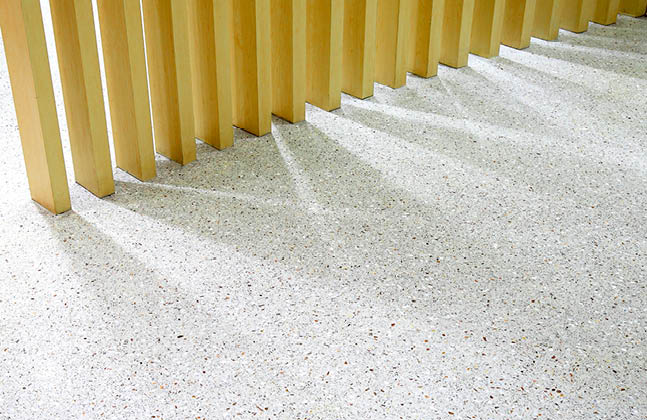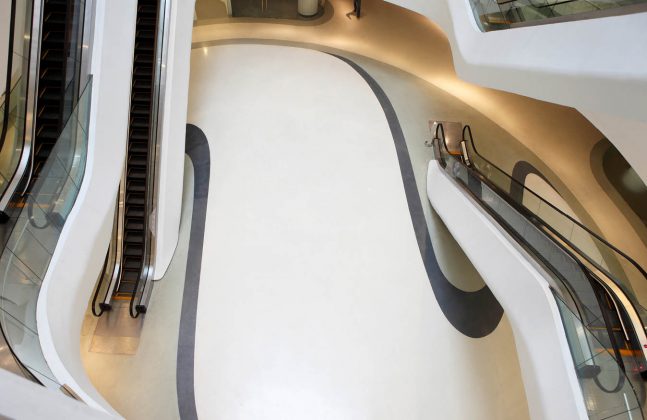Terrazzo is the trend that is standing the test of time. With flexibility in terms of design and application, this flooring solution has been chosen in a wide variety of commercial and residential spaces to create striking visuals. Covering a limitless array of colours and textures, thanks to the many aggregates available today, terrazzo is being used as much now as it was years ago to create glamorous and truly unique aesthetics.
After deliberating over the many flooring options and deciding that terrazzo is for you – make sure that you are completely clear about which type will suit your space the best.
Terrazzo flooring has traditionally consisted of marble or granite chips set in concrete and polished down to a smooth surface, creating a decoratively patterned finish of small, interspersed coloured flakes.
However, with a new trend we see new technologies, and today resin systems are revolutionising the design, installation and use of terrazzo surfaces. Thanks to the versatility of this seamless resin flooring, it provides the designers of large commercial facilities with the opportunity to think of the floor area as one considerable canvas on which they can create bespoke works of art.
Using an epoxy or polyurethane based system instead of concrete makes it easy to pour blocks of coloured resin into any desired pattern. Metal bands are used to mark out the pattern’s different sections and once the last colour has been added in, the floor area is then repeatedly ground down, sealed and polished to create a smooth and glossy finish.
With these two main options to consider, epoxy based terrazzo and cementitious terrazzo, what is the difference?
Epoxy Terrazzo
The main benefits of the resin system are greater design flexibility and speed of application.
Using an epoxy matrix to bind aggregates allows for an incredibly thin set system that consists of colour and shimmering pieces of glass, marble or granite to create a smooth and luxurious floor finish. Made from a two-component resin system that bonds directly to the concrete substrate, this is also an extremely light flooring solution.

Given the right ambient conditions, this system can cure overnight and be ready to polish the next day, permitting a faster project turnaround. This speed of application is ideal for busy shopping centres for example, as the new flooring can be installed during the normal closed times of the building.
Whilst colourful and intricate patterns can be created inside with this epoxy terrazzo, it is not suited to outdoor applications thanks to it being incapable of absorbing water.
Cementitious Terrazzo
Some cement terrazzo is much more suitable for more challenging areas, exterior applications and renovation projects where there is no active vapour barrier beneath the substrate.
Cement terrazzo uses a cement matrix and describes multiple terrazzo systems, including sand cushion, bonded, rustic, monolithic and polyacrylate systems. Using a cement based mix with the incorporated aggregates, this system is often thicker and heavier than epoxy alternatives. This thick, robust nature means that it is better at withstanding impacts, steam cleaning, heavy traffic and point loading.

Taking up to seven days to cure before polishing can commence, the application area will have to remain free from traffic until that time. For businesses, this could mean upheaval and loss of normal revenue due to closure.
Although there are not as many colour options for cementitious terrazzo as there are for resin systems, wonderful earthy tones can be created with this option.
To highlight the main differences between the two options, see the table below.
| Type | Epoxy Resin Terrazzo Flooring | Cementitious Terrazzo Flooring |
|---|---|---|
| Colour Options | Offers bright and complete colour customisation | Slightly more limited colour options |
| Thickness | Maximum thickness of 6-8mm possible | Thicker and heavier system |
| Application Area | Good for internal applications | Good for internal and external installations |
| Moisture Tolerance | Few concerns on moisture vapour transmission | Good at handling moisture vapour transmission |
| Finish | High level glossiness possible | Low level of gloss finish can be achieved |
| Curing | Fast curing | Longer duration to cure |
If you would like more information on using terrazzo for your facility, please leave a comment below and we will get back to you.
4 thoughts on “What are the Differences Between Cementitious and Epoxy Terrazzo”
Comments are closed.






What is the best type to use for a commercial retail Restroom
Hi John
Thanks for your question. Between these two types of resin chemistries, I’d opt for the epoxy terrazzo. This is because epoxy terrazzo is typically smoother, making it easier to wash, and has sufficient durability to resist the harsh cleaning chemicals, impacts and foot traffic that are typical in a busy retail restroom. It can also be tailored aesthetically to match the branding of the store that it is within. Cementitious terrazzo is a lot hardier again, but it’s unlikely that a restroom will require this level of durability.
Thanks,
Dan
Cement finishing can be as shiny as glass. Why do you say it can only be at low level of glossiness?
On the other hand with accelerators cement can be polished in 24 hours just like epoxy.
This is true, it is possible to create very shiny concrete surfaces. The reason we took this line is because this post was designed to provide a general overview of the two different types of terrazzo and in general if the applicator knows how to work with epoxy, it’s easier and quicker to create a bright, ultra-glossy surface using an epoxy system compared to a cementitious one.